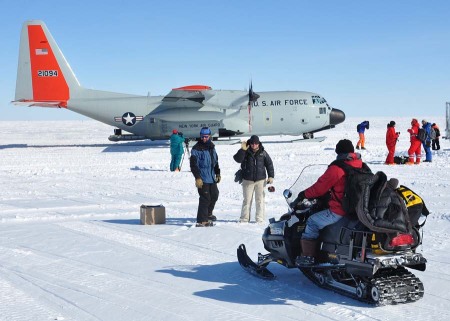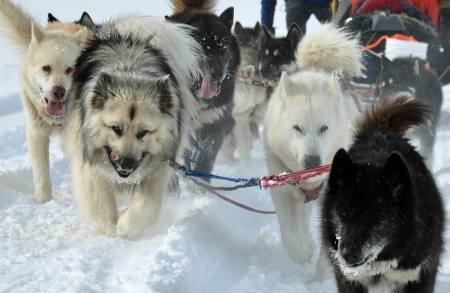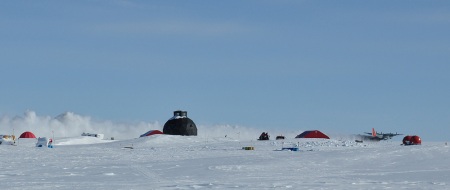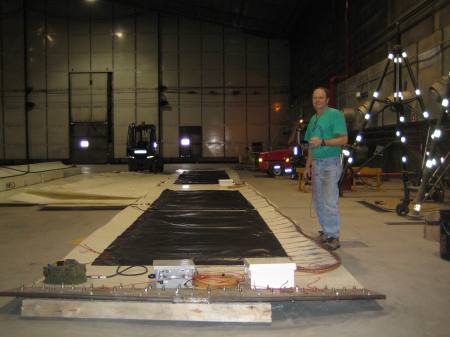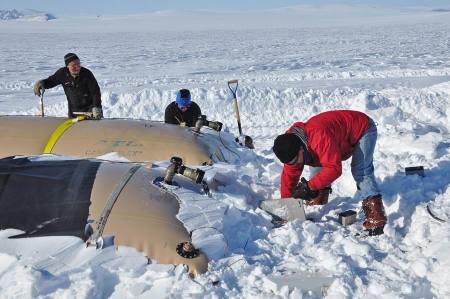Two Become One
All Photos: Robin Davies

Some gorgeous and well-mannered Polar Huskies wait for the humans to transfer the GoNorth! load to GrIT.
Adapt or fail: this may be the first rule of successful polar exploration, as countless stories from the age of the great adventurers (and from our own research clients) will attest. Over the weekend, while many of us celebrated Mother’s Day, there was a marriage of sorts on the Greenland ice sheet. The two traverse teams we’ve been following—GoNorth!’s Polar Husky-powered education effort, and GrIT’s tractor-towed operational effort—combined forces to get everyone back on schedule after last week’s stormy weather delayed progress.

Mille Porsild, dog handler-in-chief, settles the canine team atop some GrIT cargo totes. Mille prefers to ride up on the totes with her pack, though there's room for her in the warm camping wannigan.
NEEM is the North Eemian drilling camp, an international research collaboration whose main goal is to harvest an ice core (for climate studies) that reaches all the way through the ice sheet. While the University of Copenhagen has overall management of NEEM and operates the camp, the National Science Foundation supports U.S. researchers (U Colorado’s Jim White leads this effort) and provides the heavy air lift as well. Air National Guard LC-130 planes fly between Kangerlussuaq and NEEM every ten days to two weeks—weather permitting, of course.
So if the three miss this flight, they could be auxiliary NEEM staff for two weeks waiting for the next flight—an unhappy possibility given teaching and research commitments. (Some of us would pay good money to be stranded at the storied NEEM camp for a week or so with the likes of Danish polar research legends like Dorthe Dahl-Jensen and JP Steffensen, but that’s a tale for another post.)
“With the loads reconfigured (once they passed through the crevassed zone with its steep inclines), the GrIT is moving forward at a decent clip. The goal is to make at least 40 miles per day,” Allen explained. “Over the past few days, they have been achieving their goal even with some soft snow.”

Settled down and ready to make tracks.
While GrIT machines can continue plowing ahead in most storm conditions, the GoNorth! dogs, though incredibly strong and courageous, must at some point hunker down and wait for the worst weather to clear–they are not made of metal. The risk that the GoNorth! team might be delayed again by a good blow was considered too great, and so all have joined the GrIT traverse. That’s an additional 23 dogs, four people, sleds and gear.
In short, a parade.

“With firm snow, the Case has been able to hold 6th gear with little slippage,” Cornelison continued. “Ruts are between four and six inches. The Tucker has been holding second gear and keeping up with the Case though towing multiple sleds and the 3,000-gallon fuel bladder, which they have been fueling from. I believe that the Tucker load is about 120 feet long now.”
“The weather has been cooperating nicely with unlimited visibility, sunny skies, light winds and temperatures between -4 and +10F.”
“The teams camped Sunday night 110 miles from NEEM. They should arrive at NEEM mid-day on the 12th.”

Robin writes, "The Case has a Greenlandic name, Qimuttuuaraq. It's a name that's often given to a small dog that pulls hard for its weight. A rough translation would be 'Small dog with big heart'." We think the same could be said of all souls on the traverse, four- and two-legged alike.
The Greenland Inland Traverse is funded by the National Science Foundation (NSF). CH2M HILL Polar Services and Cold Regions Research and Engineering Laboratories are working together with the NSF to develop the traverse infrastructure and route. The 2010 spring traverse has several foci: find a safe overland route to Summit Station to help reduce logistical costs and environmental impacts of conducting research there; provide a research platform for scientists conducting field work in Greenland; optimize mobility by focusing on the sled/snow interface. For more field notes coverage of GrIT, click here.
GrIT contact:
Allen Cornelison, Polar Field Services, CH2M HILL Polar Services
GrIT project manager
allen at polarfield.com




 Posted by writer walker
Posted by writer walker 
